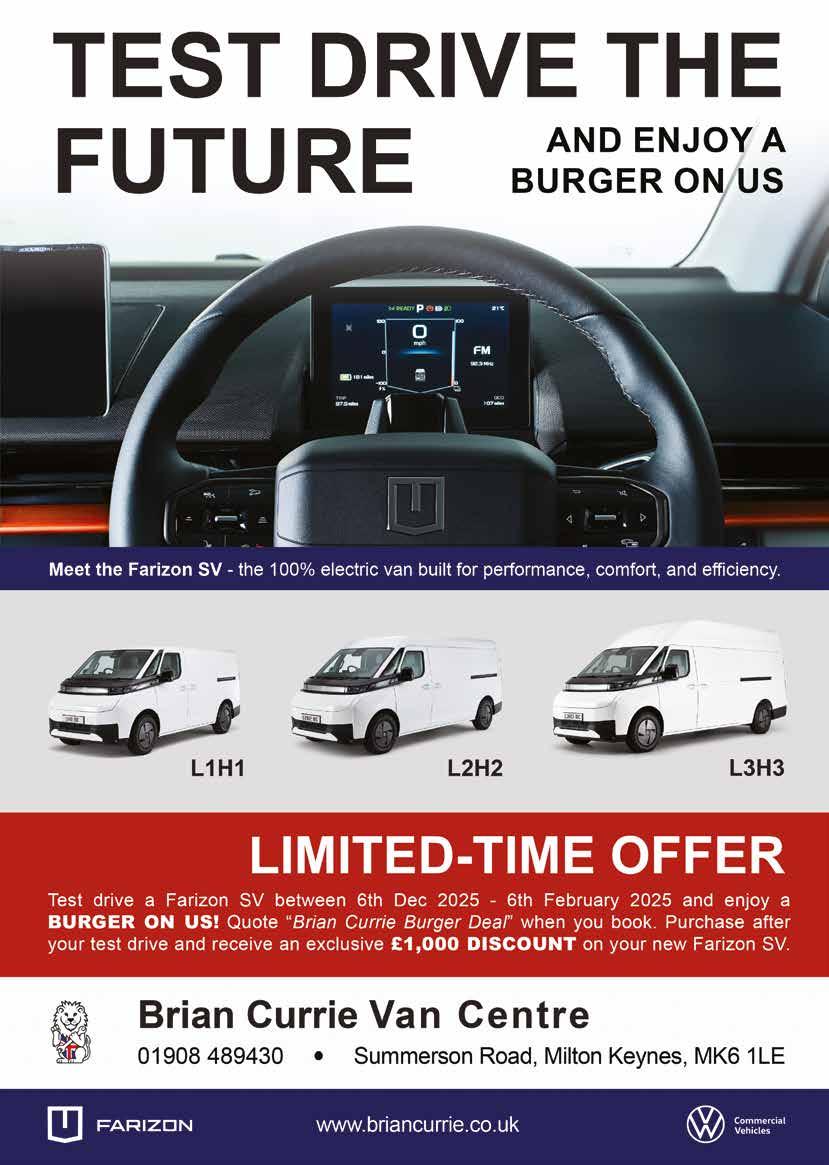
The motoring magazine for SME fleets




VAUXHALL FRONTERA
Practical EV at an exceptional price
MINI COUNTRYMAN ELECTRIC
John Cooper Works on test
CITROEN ë-C3 AIRCROSS
Ride comfort to dream of
ISUZU D-MAX
Tax-friendly Commercial has arrived

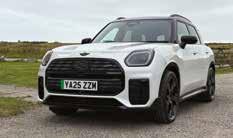

CHRISTMAS is coming and a final chance in 2025 to find out a bit more from us about that car, van or pick-up your business requires.
First up is the latest electric Kia, the EV4. With two ‘EV’ models already in the bag, can the EV4 improve on these? Read our thoughts inside.
POER is a new name with a new pick-up. We’ve a Q & A with Toby Marshall, the GWM boss, to find out why the company has launched a diesel model in 2025.
The latest Vauxhall Frontera Electric is not a throwback to the original, but arrives as a practical, family model at any amazing price point. If you need space but not the cost, it might just be for you.
Mini has electrified its range and for practical fun, the Countryman Electric John Cooper Works has plenty to offer, as we found out.
Citroen has excelled with the latest e-C3 Aircross, which rides better than an electric car should. Find out why in our review.
We also step out in the Peugeot E-5008 which comes with a 400-mile range, and the latest new car from XPENG the G6, which is arguably the best Chinese EV yet.

On the features front, Fiat is about to launch a new model in the Grande Panda range, MG’s new IM6 takes the brand upmarket, Chery launches the TIGGO 8, while BYD has a new plug-in, in the Seal 6 DM-i.
We also check out how Brindley XPENG is looking forward to a great 2026 with its new manuacturing partner.
Regular contributors Rolec update us with the latest charging news, Vanaways’ success continues and Rivervale continues to show that smaller can be better when it comes to leasing.
On the commercial front, Volkswagen’s new Transporter is on test, this time in diesel format and manages to come with some VW DNA. Farizon is a new name to the burgeoning electric van sector and its SV van has just arrived, promising a driving range up to 247 miles. We run down the facts and figures with a feature in this edition.
Isuzu has upset the tax-man with a clever addition to their range, the V-Cross Commercial. See what the fuss is about inside.
And finally, may we wish all our readers a very Merry Christmas, and we’ll see you all in the New Year.
Andrew Walker, Publisher



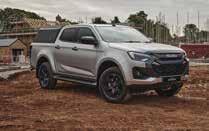

A hands-on approach –that’s the Rolec promise, as the company outlines here.
AS ONE of the longest standing EV chargepoint manufacturers in the UK, we have cultivated an extensive repertoire of projects globally. This has meant refining an adaptive approach to electric vehicle hardware that best meets the needs of sites of all sizes.
For us, it all starts with unit design. By prioritising British manufacturing and developing a team of dedicated research and development engineers, we have our hand in all aspects of product testing and design. Constantly adapting our chargepoints to meet the needs of different industries and building layouts.
Diverse product range
Units are divided into two groups: pedestals and wall-mounted units, each of which has benefits for different use cases. Pedestals, for example, are optimal for shared locations, such as workplaces and business parks. They are designed to optimise available floor space by charging up to four cars simultaneously, have increased visibility thanks to their LED amenity lighting.
Alternatively, wall-mounted chargers (like our SecuriCharge unit) are ideal for locations with limited floor space, which can be an important consideration when installing hardware in more confined areas.
With 18 years of industry experience, we are perfectly positioned to guide you through the process, from project conception and product selection to installation and support.
Support every step of the way
Our team of dedicated account managers and EV chargepoint experts are ready to provide you with all the information you need to make an informed decision about the future of charging at your business or site.
As such, we offer CPD-accredited support that includes industry insights, statistics, trends, updates to regulations, and the latest product advancements related to our solutions.
Combined with our sophisticated hardware designs, your installation will be as quick and seamless as possible. Our units feature fully removable front panels, providing ample access to internal components and making both installation and maintenance easier.
We work alongside over 40 connected CPMS partners to ensure users and operators

have access to smart, tailored features that enhance the charging experience.
it green
As UK manufacturers we maintain full control over the design and evolution of our core product range. This visibility allows us to think more deliberately about the full life cycle of our products, from conception through creation, delivery, and maintenance.
Taking a 360-degree approach, we’ve built a tailored strategy that looks at every aspect of our operations. By reducing the size of our packaging, we can ship 50% more products per pallet, cutting transport-related emissions by 33%. We also divert 70% of our manufacturing waste to recycling and continue to invest in renewable energy on site. After upgrading our solar array and reducing heating-oil consumption across the site, we generated an estimated annual CO₂e saving of 76,410kg. Alongside this, the addition of battery storage allows us to store excess solar energy to help power our factory and charge electric vehicles without drawing from the grid.
A recent BVRLA report highlights that
electric vehicles continue to dominate the leasing space: in the latest data, the leasing fleet grew by 1.4% in the past year, driven largely by salary sacrifice schemes.
Business Contract Hire (BCH), the largest portion of the lease fleet, saw a 6.3% increase, with over half of its new additions now battery-electric. Meanwhile, the average CO₂ emissions of new BCH vehicles remains impressively low, underscoring how zero-emission company cars are helping shift the sector in the right direction.
In response we have remained a reliable source of the latest DC hardware, providing powerful and scalable solutions with short lead times to support a speedy transition to green travel. All of which are easy to install, maintain and come with the full Rolec support package.
Rolec remains one of the largest manufacturers and suppliers of smart OCPP compliant AC fast and DC rapid chargers. Our extensive stock holding enables us to offer next-day delivery across our AC range and just 3–5 day delivery on the DC range of stocked chargers.
Visit our website: rolecserv.com where you can view our full product range.




We drove the Countryman Electric 12 months ago and were pleasantly surprised at just how much fun it was. But Mini obviously felt it wasn’t fun enough and recently launched a John Cooper Works version, which we spent a week in recently...

Tell me more?
John Cooper Works is in effect its own trim level within the Countryman range and comes very well equipped, with adaptive LED headlights, heated front seats, a head-up display, keyless start, Bluetooth, Apple CarPlay and Android Auto connectivity with SatNav.
Battery and performance
The Electric JCW Countryman is fitted with a useable 66.5kWh battery which offers 258hp and 340Nm of torque. Top speed is 124mph and 0-62mph takes just 5.9 seconds.
Mini’s engineers have developed an all-new electric boost function to further enhance power delivery, giving the driver an additional 20kW of electric motor power once John Cooper Works mode has been activated; this is via a rocker switch on the steering wheel. The JCW suspension maximises handling, while high performance grip tyres come as standard on all electric
When fully charged the maximum driving range when we set off was 243 miles, assuming you were sticking to ‘Green’ mode. After a 90-mile journey that included a range of mixed road and motorways we had 126 miles remaining, so a little bit of slippage – and the test was in fine weather. The problem is, even in Green mode, the temptation to play around with the JCW tuning is almost irresistible, which probably accounts for my figures.
The interior features a textile -nspired dashboard front which runs the width of the car and onto the door panels. Four slim vertical chrome air vents and the circular speedo infotainment screen are the only instrumentation on the dash, with some neat toggle switches located underneath. These include the starter button, driving
modes and gear lever. Beneath this on our JCW test car was a landscape phone charging pad, twin cup holders and a large armrest with storage underneath. The interior door handles are vertical, chrome, narrow and very tactile and the front seat headrests feature a neat oval shaped hole. The quality throughout is excellent and to keep up Mini’s green credentials, much of what is used is from recycled textiles.
Of course a new MINI, in line with sister brand BMW, will add extras in packs to pimp your car up to the spec you want. Add a Sport Pack costing £3,700 and you’ll get sports stripes, a John Cooper Works steering wheel, a black roof, sport brakes, sport seats, an Anthracite roof lining and Sport trim. And the Level 3 pack at £5,300, and this comes with even more useful additions such as the panoramic glass sunroof, sun protection glass, electric memory sears, 22kW high speed charging, a Harman Kardon sound
system, high-beam assist, Parking Assist Plus, Driving Assistant Professional and Mini SatNav.
Infotainment
The system fitted to the Countryman is called the Mini ‘Interaction Unit’ and it runs an Android-based System 9 operating software. This has been specifically designed to look and feel similar to a modern smartphone, so you can stream video and play games on it, too. It also offers the Mini Experience Modes whereby you can configure different settings Core, Green, Go-Kart, Vibrant, Timeless, Balance and Personal. Only three – Go-Kart, Core and Green – actually change the way the Countryman Electric drives, by either altering the levels of regenerative braking allowing for an increased range, lightening or tightening the steering most noticeable in town and will increase or decrease accelerator response, something you’ll get hooked on in Go Kart mode.
The circular display is in keeping with Mini’s heritage with the operating system, graphics and speed all very impressive. Now we’ve driven the new Mini on a number of occasions the set-up and screen menus have become much easier to use, although a quicker way to turn off some safety features than going into a number of menus would have been appreciated. Having the climate controls on the screen is also a little distracting.
Practicality
The elongated Countryman, even in electric format, offers a 460-litre boot, rising to 1,450 litres with the rear seats folded. The boot floor also has some useful hidden space beneath. with room for your cables. And better still, the rear seats can be moved back and forth by as much as 13cm, with the seat backs individually reclining in six positions by up to 12 degrees. This puts it firmly in the small family SUV sector as far as practicality goes.
Up front the door pockets are massive, with smaller ones in the rear. There are four USB C inputs, two in the front and two in the rear, a useful sized glove box, the wireless charging pad, twin front cup holders and the armrest with storage beneath.
The Countryman also features Mini’s new Level 2 semi-autonomous driving tech. This includes Automatic Active Cruise Control with Steering and Lane Assistant, which allows drivers to take their hands off the steering wheel at speeds up to 37mph. As part of our test car’s extras, adaptive LED headlights, High Beam Assist, Driving Assistant Professional and Parking Assist Plus were also included.
With 494Nm the Countryman JCW will accelerate from 0-62mph in 5.6 seconds.
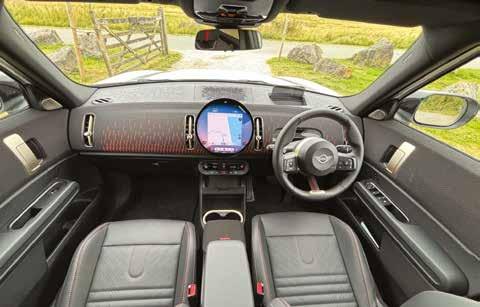
If you’re mainly charging at home, the Countryman Electric comes with a standard 7.4kW set-up, so a full charge from empty will take about nine hours. Opt for the on-board 11kW charger and that will reduce the time to six hours. You can also add as another option to your electric Countryman, a 22kW AC system for faster charging away from home. We use a Rolec charger: http://www.rolecserv.com/home-charging
The longer wheelbase brings with it a more comfortable, less fidgety ride than the Electric Cooper and Aceman. The addition of the battery and electric motors on the electric version, all 450 kgs of it, somehow making the electric version just as much fun to drive as the petrol model, which is no mean feat. However, the ride is a little harsh over poor road surfaces, and the battery weight becomes much more noticeable.
We took it for a spin around north Cheshire where we have some surprisingly good roads between Manchester, Buxton and Stoke on Trent. It handles impressively and the extra weight makes it feel even more stable in and out of faster twists, turns and corners. The JCW tyres also add to the feeling of grip even on some gravel we encountered on our way down the Cat and Fiddle pass.
Add in some rain and the JCW version performed incredibly well when driving quickly on B roads.
Our next trip was to the beach at Formby, where we took in the M56, M6 and M58. Motorway cruising and the Countryman Electric are made for each other. Select your speed, initiate cruise control and away you go. It’s smooth, quiet, refined and comfortable. And if you’re canny drive in Eco mode with the B regeneration on and you’ll take advantage in any stop-start traffic to add some range to your battery.
Talking of which, in town or urban
situations the JCW version is just as impressive as the standard Electric Countryman, offering a safe and agreeable cabin where the speakers shine, the connectivity works well and hands-free calls don’t require raising your voice.
Comfort
Up front there’s plenty of width to the car so you sit comfortably in the sports seats. In the rear two six-footers will be happy with the head and legroom with only the centre passenger a little squashed. Two rear USBs is good news for those sat in the back
Pros
Roomy, comfortable and a fun to drive. Retro details are clever as well as useful. For company car drivers, 3% BIK is a steal.
Cons
Hard suspension isn’t for all. As per usual with Mini, you have to pay more to get the extras you may want. Electric versions cost more than petrol versions.
The JCW Countyrman Electric is great to drive and you’ll certainly have fun behind the wheel. However, it’s also a comfortable and practical family car, offering decent interior space and a useful boot. Kudos too for the inclusion of the old-school central infotainment screen and toggle buttons, which really make it stand out. In effect the JCW frills don’t really add much more enjoyment to the car than if you opt for the ALL4 model, but the added JCW trim certainly lifts it above a standard electric Countryman.
CC&V RATING: N N N N


For those of us old enough to remember the 80s, the Vauxhall Frontera will be remembered as a chunky 4WD SUV based on an Isuzu.
Powered by petrol and diesel engines, it disappeared in 2005, only to be resurrected in 2025 as a much more family-friendly small SUV. We popped down to the West Country to put the electric version through its paces, and discovered a clever car that’s very competitively priced.
Tell me more?
The Frontera, Citroen C3 Aircross and Fiat Grande Panda, share the same Stellantis ‘Smart Car’ BEV-native platform, which has been developed across for both electric and ICE drivetrains.
There are four options which are all front wheel drive. Two petrol engines, a 1.2-litre three-cylinder hybrid, offered with 99bhp or 134bhp, or two electric models, fitted with either a 44kWh or 54kWh battery and single electric motor with 111bhp.
Prices
After the Government announced that every Vauxhall EV was eligible for the £1,500 Electric Car Grant (ECG) from August 2025, the entry level EV in Design trim will cost £22,495 while the higher-spec GS starts from £24,495. In comparison the Frontera Hybrid starts from just over £24,000.
Trims
Three are offered. Entry level Design comes with a 10” touchscreen, Apple CarPlay and Android Auto, LED headlights and 16”
wheels . GS adds 17” alloys, front parking sensors, blind spot alert, a black roof, high-gloss black wing mirrors, a black Griffin logo, dark silver skid plates, tinted rear windows and LED taillights. The Ultimate model includes high gloss black roof rails with a 240kg load capacity, LED front fog lights, heated seats, steering wheel and windscreen.
While an almost identical model to the Citroen C3 Aircross, Vauxhall’s design is clearly evident with the brand’s Vizor grille and Intelli-LED headlights at the front. Vauxhall has also managed to introduce a curvy C-pillar which stands out best with the contrasting black roof. The upright rear features Frontera lettering with a new light signature of three blocks, with large low down silver coloured bumper.
Interior
Compared to the C3 Aircross it’s a little conservative, with black, chrome and greys dominating on the dash front, seat fabric and doors. There’s plenty of generic Stellantis switchgear on offer and the same ‘Pure Panel’ design as other Vauxhall models. Two 10” displays, one for the instruments and the other for the infotainment.
The use of physical buttons for some key functions in the Frontera is good news, as is the three-spoke, flat-bottomed steering wheel contains buttons for cruise control on the left and the infotainment and phone on the right. The wheel itself is compact meaning you can see both the driver’s display and heads-up display clearly.
The seat covers feel tough and durable and the finishes are generally good with just
some cheaper scratchy plastics in the usual spots, out of sight, down low. There’s also an adjustable band on the centre console that’s been cleverly designed to fit drinks containers of varying sizes. All-in-all it’s impressive at the price point.
Lifted from many other Stellantis models, the info system is easy to use, features clear graphics and connects promptly to CarPlay. Separate climate controls sit beneath the screen, which is more good news. Wireless Apple CarPlay and Android Auto are included as standard.
Four USB-C ports also come as standard along with a wireless smartphone charger. It’s easy to use but perhaps feels a little basic when compared to some newer offerings out there.
This is where the Frontera really shines, with the option of a third row of seats on GS and Ultimate hybrid versions. Two-way adjustable headrests and a ‘fold and tumble’ seat mechanism also provide easy access to the third row when fitted.
Cabin compartments offer interior storage of up to 23 litres, while the 60:40 split second-row seats and a two-level boot floor mean a capacity of 1,600 litres with the rear seats down, 460 litres when they’re in place.
The boot opening is also pleasingly large and almost square, with a low load lip to make loading and unloading very easy. The availability of roof rails with 240kg capacity enhances the Frontera’s load-carrying credentials further.
Continued on page 12

Continued from page 10
Battery and Range
Two battery configurations are offered.: a Standard Range 44kWh battery with a claimed WLTP range of up to 188 miles, and the larger Extended Range 54 kWh battery which increases the range to 249 miles.
On our shortish test route at temperatures outside of 12 degrees centigrade we were seeing a return of 3.8 miles/kWh. Our experience of the larger 54kWh battery fitted to other Stellantis models would suggest a range of 220-240 miles on mixed roads in warmer weather and 180-200 miles as the nights get colder for the Extended Range model.
Electric ‘all in’
It’s worth mentioning that Vauxhall is making more effort than most brands when it comes to helping customers into an EV with Electric All In. This includes eight years of comprehensive roadside and emergency charging assistance, eight years/100,000 miles battery warranty for at least 70% of the original charging capacity.
For those taking their first EV step, choose from £500 credit to be used towards either an Ohme home charger installation, or Tesco charging credit, Octopus Electroverse credit or a Connected Kerb credit, a more than generous 10,000 miles’ worth of free home charging when switching to the Intelligent Octopus GO home energy tariff. This also includes unlimited access to Connect Plus, giving access to the full suite of connected services available through Vauxhall Connect. In addition, thanks to Vauxhall’s partnership with Tesco, retail customers can collect 50,000 Tesco Clubcard points when they purchase a new car through a participating Vauxhall retailer. This offer applies to all new Vauxhalls, and not just those with electric powertrains.
As with all manufacturers’ new cars, the Frontera is packed with safety features. These include automatic emergency braking with pedestrian detection, lane keep assist, speed sign recognition, driver drowsiness alert, forward collision alert, blind spot alert and cruise control with speed limiter.
Charging times from 20-80%
In the smaller 44kWh version, if you’re out and about, a DC rapid charger will take 26 minutes or 28 minutes for the 54kWh model. At home on a 7.4kwh charger the times are four hours 10 minutes or just over five hours respectively.
The Frontera Electric takes 12.8 seconds to reach 62mph with a top speed of 87mph. The 54kWh Extended Range model takes 13 seconds to reach 62mph. With 111bhp and just 125Nm of torque these figures are hardly

surprising although unlike many EVs, the electric Frontera doesn’t offer a low down acceleration which was a surprise.
Out and about
We took our 44kWh model out on a test route that encompassed all types of driving roads, and while it’s a doddle to drive it’s hardly exciting. This is missing the point a little, as to be fair to Vauxhall, its electric Frontera does what it says on the tin. It’s a spacious and comfortable ride with enough hi-tech kit to keep you interested, but practicality is its main strength. Both the infotainment screen and the driver information display can be personalised, while a rear-view camera on all models makes reversing easy.
Head and legroom up front is excellent, as is the surprisingly good rear space. It’s worth noting that battery positioning in the Electric means the rear floor is slightly raised compared with the Hybrid, resulting in higher knees, but it’s a very minor difference.
The cabin’s bright and airy and the upright driving position gives a good command of the road ahead. Road noise is noticeable at 40mph+, especially on wet tarmac, but there is a lot of glass on offer, so perhaps no big surprise. Ride comfort is pleasingly good, masking the worst aspects of battery weight and poor road surfaces. While the steering is light and responsive, don’t expect much feel: it’s very much a city cruiser, at which it excels.
If you do hit the motorway then don’t despair. Cruise control is standard and although acceleration is slow, once up to speed this car will sit happily at motorway speed limits. We’d also like to praise Vauxhall’s sound system which is really good. We had connected our iPhone to CarPlay easily and quickly and listening to our favourite podcast at 70mph didn’t mean we struggled to hear it.
Alongside sister model the C3 Aircross, it’s amazing value for money. Clever thinking has also delivered a practical and user-friendly cabin. For company car drivers you get a family sized-SUV with just 3% BIK. Vauxhall’s excellent ‘Electric All In’ support package is another plus.
Cons
The cabin and ride aren’t quite as good as the C3 Aircross offers. Some lower down plastics and surface finishes feel cheap and cheerful.
While it does a great job of carrying five passengers and their luggage, it does feel slow and not very engaging.
Like a defensive midfielder, the electric Frontera does all of the stuff that needs doing, without making a song and dance about it. Spacious, tick. Comfortable, tick, well equipped, tick, practical, tick, and perhaps best off all, an absolute bargain, price-wise!
If you’re expecting electric thrills this isn’t the car that delivers and it doesn’t have the same ‘uptown-funk’ the C3 Aircross offers. However, Vauxhall’s EV commitment is to be commended, as is the willingness to price-point a practical EV at under £23,00. You’d have to pay a bit more for our favoured model, the 54kWh GS at just under £30,000, but even so this car is a steal !
CC&V RATING: N N N N N


Peugeot’s E-5008 offers seven-seat practicality in the burgeoning electric SUV sector. With a 2.90m wheelbase and overall length of 4.79m, Peugeot has built a clever people carrier that doesn’t have too large a footprint.
Built on the new STLA Medium Electric powertrain, the drivetrain comprises a permanent magnet synchronous motor operating in tandem with an electric gearbox to deliver more power, efficiency and torque, powered by a 400V lithium-ion battery. In efficiency terms its range is massively improved over the preceding Stellantis BEVs, with up to a 416 miles now available.
For AC charging, two types of on-board chargers are available, with an 11kW three-phase charger as standard. For DC rapid recharging, the Mode 4 socket on the new E-5008 is capable of charging speeds up to 160kW, enabling the E-5008’s standard range battery to be recharged from 20% to 80% in 30 minutes. Plug-in at home and on a 7.4kWh charger and charging takes eight hours from 20%-100%, or six hours from 20%-80%.
The E-5008 also features V1G or Smart Charging function which can adjust the time and power at which the battery is charged to
optimise charging costs. A heat pump are an extra charge item.
The E-5008 comes with two new larger batteries: a 73kWh battery with a range of 311 miles, the model we tested, and the larger 98kWh battery with up to 416 miles of range. Both are single motor. A Dual Motor AWD is also available fitted with the 73kWh battery and comes with a 311 mile range.
There are three trim levels: Allure, GT and GT Premium . All are offered with a choice of 73kWh or 97kWh batteries, with single motor powertrains. The single-motor versions offer 345Nm/157kW or 345Nm/170kW.
The dual-motor AWD version, available on GT Premium, provides a total power output of 320hp, a split of 157kW at the front and 80kW at the rear for a total 237kW. The front motor delivers 345Nm of torque and the rear motor 170Nm.
Allure costs from £48,560 with the smaller battery with prices rising all the way to £57,290 for the AWD GT Premium.
The front end comes with slim LED headlamps, lions claw vertical light strips and a large Peugeot logo in the centre of the
diamond-shaped front grille. Both versions also come with Peugeot-emblemed wheels, an aerodynamic profile, a narrow rear light band and a floating spoiler.
The i-Cockpit is still there but it’s had a major facelift. It’s now the ‘Panoramic’ i-Cockpit and features a floating, curved 21” HD panoramic screen that combines the head-up display with the central touchscreen. Slightly curved towards the driver, the screen looks fantastic and although most functions are accessed through it, Peugeot has sensibly included i-Toggles, their fully customisable touchsensitive buttons that can be programmed to provide quick access to up to ten of the user’s favourite functions; phone contacts, air-con and SatNav, for example.
The instrument cluster sits in front of the driver, combining all the information relating to driving such as speed, power, driving aids and energy flow. You still have Peugeot’s compact steering wheel – now with touch-sensitive controls – but the larger cluster is far easier to see above the wheel than before, a major plus for taller drivers. Ambient lighting and Peugeot’s Air Quality System (AQS) also feature.
Continued on page 14

Continued from page 13
Fixtures and fittings
Quality wise it’s the finest Peugeot cabin yet. Our test car, the GT, featured a light grey textile decor for dashboard, door panels and central console arch, Alcantara seating with leather effect seats and ‘Mistral’ black pillars and headlining. All of the finishes are excellent including the plastic glove box front and door pockets.
Our GT test car came very well specced and included dual zone climate control, heated and ventilated seats, a heated steering wheel as well as tinted privacy glass for the rear doors, a hands-free foot operated tailgate, front and rear parking sensors, a reversing camera, an 11kW on board charger, three 12V sockets located in the cabin front, rear and boot.
Also included are automatic headlights, LED exterior lighting, pixel LED technology headlights with adaptive high beam assist, 3D LED rear lights and 20” ‘Yosemite’ two-tone diamond cut alloy wheels.
Performance and economy
Top speed is 106mph with a 0-62mph time of 9.7 seconds. WLTP Combined range for our test car’s smaller 73kWh battery is 311 miles. With zero CO2 emissions, BIK is a tempting 2%. WLTP numbers suggest the E-5008 can hit 4.6 miles per kilowatt-hour, and on our test which include motorways, we were just above four miles per kWh, so it’s doable.
Practicality and interior space
Up front there’s a twin cup holder in the centre console, a glovebox, decent sized door pockets, with the rear central armrest also featuring two cupholders and a smartphone holder. The boot offers 40/20/40 folding rear seats and a boot volume of 916 litres in a five-seat configuration, 348 litres in a seven-seat configuration and up to 2,232 litres in a two-seat configuration. You can also store the parcel shelf under the floor, a nice touch, or use this space to hide a charging cable.
There’s good passenger room on board with front seat passengers spoiled by the
head and legroom available. The centre binnacle cocoons the driver in a comfortable driving position with easy access to the new touchscreen and dashboard functions. Second row passengers get good headroom and legroom and all three second row seats are individually adjustable. The third row of seats enables the E-5008 to be a sevenseater, but the space afforded by these isn’t really big enough for adults to use except over short distances.
Peugeot has made accessing the third row of seats easier than many rivals, thanks to the easy access system. This allows the seats in row two to be fully tilted and slid forward simultaneously. Combined with the wide opening offered by the large rear doors, you can get on board or out, with some dignity.
The HD touchscreen is fully customisable with ‘over the air’ map updates for the SatNav. Wireless Mirror Screen for Apple CarPlay and Android Auto, DAB, AM and FM radio, Bluetooth with two microphones so you can connect to two phones, and a Smartphone wireless charger. Four USB sockets, two front and two rear, also feature. We connected our iPhone seamlessly and the massive screen is both clear and easy to work, with the functions quick to load.
E-5008 has you very well protected and comes with adaptive cruise control with Stop and Go, lane keep assist, speed limit sign detection, automatic emergency braking with collision warning, lane departure warning, Driver Attention Alert, long-range blind spot monitoring and Advanced Traction Control.
The new platform incorporates new front and rear axles and the single layer battery which sits low between the wheels. In theory this should help the ride, but as we’ve discovered it’s a near impossible trick to pull
off. However, although sharing its underpins with the smaller E-3008, the E-5008 feels more grown up as an electric car, more balanced and less fidgety; that was a bit of a surprise, but a nice one at that.
Elsewhere, the steering is pretty good and it manages to feel agile over undulating surfaces and through tight turns, with little or no body roll. The steering is quite light which is a bonus for urban driving, and the on-board parking aids make tight spaces accessible. The paddle-mounted brake regeneration is a really good addition, as is the latest Panoramic i-Cockpit – still one of the best we’ve come across.
On the motorway the adaptive cruise control makes longer journeys stress-free. It’s all carried out within a quiet cabin aided by the acoustic windscreen and the car’s sleek design. Very serene.
As far as the driving regeneration modes are concerned, we found that Low offers up a normal driving experience, Medium adds a tiny bit of regeneration and High a little bit more, but it’s some way off the no-brakes required one-pedal motoring on the KIA EV6 or Hyundai Ioniq 5, for example
Three driving modes – Eco, Normal and Sport – give you what you’d expect. Eco tones everything down and will help you eke out extra miles, Normal is a bit more fun, while Sport is the most noticeable in changing the driving dynamics.
We loved the look of the E-3008, but the E-5008 is even more handsome. It’s nimble and good fun to drive, despite being a seven-seater. A choice of two large batteries with class-leading range means the E-5008 offers far more appeal than previous electric Peugeots. On trend tech and safety plus BIK of just 2% gives it company car appeal.
Other BEV seven-seaters offer more third-row head and legroom and a larger boot. Both versions are expensive to buy, so leasing is the logical way to get one. When others offer one as standard, paying extra for a heat pump is a little tight of Peugeot.
Good looking, comfortable and well equipped. A bonus is that it drives better than the smaller E-3008 and offerings from Kia and Hyundai. Battery range smashes all other seven and most five-seat SUVs out of the park. A company car driver or fleet manager looking for long range will be eyeing the E-5008 eagerly... particularly when it is so driveable.
CC&V RATING: N N N N N

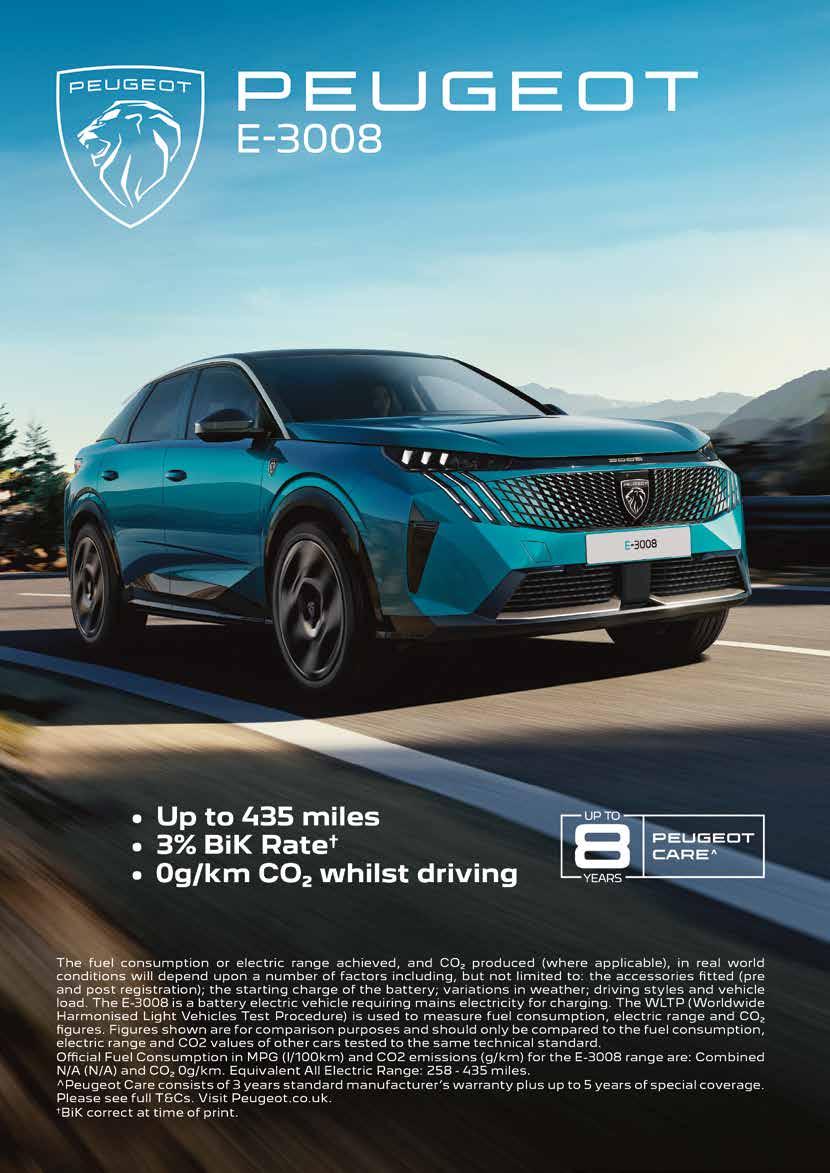
VANAWAYS has supplied Santis Global with a new fleet of Volkswagen ID. Buzz electric vans – marking a major step in the Londonbased courier’s journey toward a fully sustainable delivery network.
Finished in sleek black metallic and wrapped in a bold, custom design by Cube Branding, the four ID. Buzz vans are already drawing attention across the capital.
Driving sustainable change
For Santis Global, sustainability is far more than a buzzword – it’s central to the company’s mission to redefine city logistics. To support that goal, Vanaways’ Business Development Director, Liam Nicholas, sourced the all-electric ID. Buzz to meet Santis Global’s need for zero-emission performance, practical city design, and standout presentation.
The ID. Buzz delivers on all fronts: generous cargo capacity, advanced driver-assistance systems, and a comfortable, high-tech cabin. With its urban-friendly range and zero tailpipe emissions, it’s ideally suited to London’s Ultra Low Emission Zone and the increasing environmental expectations of corporate clients.
“We work with major companies who expect us to demonstrate a commitment to sustainability,” explained John Pye, Managing Director at Santis Global. “Upgrading our fleet with the ID. Buzz was a natural step forward.”
Partnership in progress
The collaboration between Santis Global and Vanaways underscores both companies’

commitment to greener transport solutions.
“We take pride in supplying vehicles that support our clients’ long-term sustainability goals,” said Liam Nicholas. “For Santis Global, the ID. Buzz offered the perfect mix of innovation, practicality, and eco-performance.”
Drivers have embraced the change, too. “The quality of the cabin is fantastic – it feels like a luxury car,” added Pye. “Our typical routes are 30–50 miles a day, so a single weekly charge works perfectly.”
Wrapped for impact
The fleet’s visual transformation was executed by Cube Branding, whose creative team produced a bespoke wrap that turns each van into a mobile work of art. Featuring London landmarks such as the London Eye, Big Ben, and The Shard intertwined with
futuristic circuitry, the design reflects Santis Global’s blend of technology and environmental responsibility. Glow-in-thedark elements add extra flair, celebrating the firm’s secure overnight delivery service.
“Cube Branding did an incredible job – the vans look absolutely stunning,” said Pye.
Leading the way
As sustainability becomes a core requirement across the logistics industry, Santis Global’s investment in the Volkswagen ID. Buzz positions it at the forefront of the green delivery revolution. Supported by Vanaways’ sourcing expertise and Cube Branding’s creative vision, the project exemplifies how collaboration and innovation can drive meaningful change on the road to Net Zero.


CITROEN’S new C3 Aircross has been launched and the good news is that the electric version will cost from under £25,000. We loved the e-C3 enough to make it our 2024 Car of the Year, so the Aircross version has a lot to live up to. Luckily it’s a large car with a small footprint and will even be offered with seven-seats, massively undercutting the price of all other seven-seaters in the process. And to keep everyone happy there’s a standard petrol and a petrol hybrid version, too.
In the fleet sector it’s the electric model we’re focusing on, and we drove the new e-C3 Aircross; here’s what you need to know.
Drivetrain and regeneration
The e-C3 Aircross is powered by a front-wheel drive single electric motor producing 83kW (113 ps) for both the Standard and Extended-range versions. The gear selector features a C option not the usual B for regeneration, a change from existing Stellantis EVs. Basically the e-C3 Aircross always starts up in Eco mode, with the C setting for Normal mode.
Model range and trims
Two trims, PLUS and MAX. PLUS is well appointed coming as it does with Citroen’s Advanced Comfort Seats and Suspension,
automatic air-con, LED lights, lane departure warning, a rear parking camera, 17” alloys a 10.25” touchscreen with Apple CarPlay and Android Auto
MAX trim adds 3D SatNav, a heated steering wheel, front seats and windscreen, front parking sensors, LED rear lights, two-tone paint, wireless smartphone charger and blind-spot detection.
All versions also feature the Visibility Pack, which includes automatic rain-sensing front windscreen wipers, rear windscreen wiper with intermittent mode and ‘Welcome’ and ‘Follow-Me-Home’ lights.
e-C3 Aircross prices
In Plus trim, the Standard Range model starts from £23,095 with the Extended range priced at £24,995. Max models add £2,000. Good news is that all versions benefit from the Government’s £1,500 EV grant, so the electric range ends up being priced between £21,595 and £25,495, which is less than the hybrid model.
Battery and range
Two battery configurations are offered. A Standard Range 44 kWh battery, with a claimed WLTP range of up to 188 miles, or the larger Extended Range 54 kWh battery
which increases the range to 249 miles. On our shortish test route at temperatures outside of 15 degrees centigrade we were seeing a return of 4.1 miles/kWh.
Our experience of the larger 54kWh battery on other Stellantis models would suggest a range of 220-240 miles on mixed roads in warmer weather, and 180-200 miles as the nights get colder.
Charging
The e-C3 Aircross comes with a standard 7.4 kW onboard charger, so plug-in at home and you’ll get your battery charged from 20%-80% in 4h 15 minutes with the 44 kWh battery. DC rapid charging is up to 100 kW, allowing a 20%-80% in just 26 minutes. With the larger 54 kWh battery add 30 minutes and 5 minutes respectively.
Performance
With 111bhp and 125Nm of torque, you get a 0-62mph time of 11.7 seconds for the Standard Range with the 44kWh battery which is hardly quick. If you opt for the larger 54kWh battery fitted to the Extended Range, it’ll take 13 seconds.
Continued on page 18
Continued from page 17
The design adopts a more upright, rugged SUV stance rather than a supermini look, but fear not, Citroen has cleverly camouflaged the boxy shape so that until your close up it looks smaller than it actually is. The EV features a blanked-off grille with large Citroen logo dead centre. Deep, low down air intakes and corner LEDs finish the front. At the sides robust wheel arches, roof rails, 200mm ground clearance and cladding give it a crossover appeal, with the rear hatch finished with signature LED corner lights, Citroen logo and Aircross lettering.
Large doors, a high driving position and good visibility all make the e-C3 Aircross a practical proposition. Furthermore, the five-seater version of C3 Aircross has a 40/60 bench seat that is 65 mm further back than on the seven-seater version, the result being best-in-class knee room in the category at +80 mm compared with the segment average.
In the cabin itself, and even with some generic Stellantis bits such as the 10.25” touchscreen, gear selector, electric hand brake and window switches, there’s plenty of Citroen touches. Look out for the padded memory foam seats, the Citroen Advances Comfort System, the funky fabric on the dash and cool corner air vents. It’s all done tastefully and to a budget, but Citroen has done really well with the contrasting colours and textures, which are all part of the brand’s ‘C-Zen Lounge’ concept.
The steering wheel contains buttons for cruise control on the left and the infotainment and phone on the right. The wheel itself is compact, meaning you can see both the driver’s display and heads-up display clearly if fitted.
Lifted from many other Stellantis models, the system is easy to use, has clear graphics, connects promptly to CarPlay and is backed by a slim horizontal digital driver’s display. Separate climate controls sit beneath – more good news. Wireless Apple CarPlay and Android Auto are included as standard.
Although the EV is only offered as a five-seater, the broader C3 Aircross range (petrol/hybrid) includes a seven-seater configuration which is well worth noting. In the cabin are a small glovebox, twin centre cup holders, under armrest storage and large door pockets, plus space on the dash top for odds and ends.
Twin USBs in the rear will keep passengers happy too. A box-shaped 460 litre boot, 1,600 litres if you fold the 40/60 rear seats down, also adds to the feeling that this is a car that makes cleve use of space.


We were testing the entry level PLUS model and the first thing to say is that the cabin is a combination of clever and comfortable. A car this small shouldn’t be as spacious as it is, but my 6ft 5” driving companion had plenty of leg and headroom in the front.
Out and about and you’ll notice that it’s neither quick nor thrilling. It’s very much a car built to do a job, which is taking a family where it needs to go with little or no fuss.
There’s acres of head and legroom, shaming larger SUVs in this respect, and if you do need to utilise the boot, the large squarish opening makes loading or unloading easy. The PLUS doesn’t feature an electric boot nor any kind of grab handle, rather a hidden hand hold which is a little awkward to reach, and our only gripe.
Despite its upright stance, a combination of light steering and excellent suspension make for entertaining driving, nonetheless. This Citroen does an excellent job of masking road imperfections and the battery weight leaving passengers to enjoy the ride.
If you go faster than 40mph you will notice a touch of wind and road noise entering the cabin, especially on the motorway, but it’s genuinely not a deal breaker. With cruise control included it’s a really easy car to drive long distances and even though the infotainment set-up is more basic than some competitors , you can utilise CarPlay, as we did which allows you to choose your own map App, Waze in our case.
It’s the most generously priced car we’ve driven this year and comes with a lovely cabin that’s both spacious and practical. The Citroen Comfort Seats and suspension are a bonus on a car at this price point. Low BIK and decent driving range in 54kWh form make it fleet-friendly.
Cons
It has been built to a price point so some lower down plastics and surface finishes are not premium. It may be easy to drive but it doesn’t offer much in the way of driving fun, and certainly isn’t quick. It’s very much a car bought with your head and not with your heart.
Citroen’s done it again. We like the e-C3 for precisely the same reasons we like the Aircross version. It offers an amazing price point, this time for a family EV, and really throws down a gauntlet to the new Chinese brands.
In the fleet sector this electric model will cost significantly less to lease than many electric SUVs, while offering at least as much if not more practicality. And it smashes ride comfort out of the ball park. On the down side, some cheapish finishes are noticeable, the hatch could do with a grab handle to close and it’s slower than most other EVs. None of this matters, though, when you look at the price.
CC&V RATING: N N N N N

GWM UK, part of International Motors, has launched a new pick-up, the POER300, and we spoke to UK boss Toby Marshall to find out more about this and sister brands ORA and Haval’s plans as we head into 2026.
Q1. Some readers may be wondering why you’ve launched a diesel pick-up when electric trucks are on the horizon. What made GWM go with a diesel pick-up?
Toby Marshall: It may look like a bold move at the outset, but this has been carefully considered. GWM sells this pick-up very successfully in other markets such as Australia, so when the opportunity to take this in the UK arose, we jumped at it.
There is still a market for those who need a pick-up as a hard-working tool for business. There is also a share of this market that is not ready for electrification for a number of reasons. Therefore, a diesel pickup that offers value for money and hard-working credentials can fit the bill. This is where the POER300 shows its strength.
CC&V: What does the POER offer that will attract new pick-up customers?
TM: First and foremost, the POER300 is a value-for-money proposition. We have seen prices for pick-ups climb steadily in recent years, opening some space for a competitive and capable vehicle to enter the market. We believe those in the agricultural industry, building and construction and services are our main customers.
CC&V: Your dealer network will now sell the POER, Haval and ORA models. Will they be familiar with what a pick-up customer is looking for?
TM: We have completed extensive dealer sales and aftersales training for the POER300, which is a different proposition for our dealers, being a commercial vehicle. We, as a company, have vast experience in the pick-up market, so we don’t see this as a barrier. It is an opportunity for the growth of GWM.
CC&V: Talking of ORA you currently have two model’s one of which, the O3 is electric and fleet-friendly. Do you have any hopes for this model in the corporate sector?
TM: When we launched ORA a couple of years ago, it was the only sub-brand from GWM destined for the UK. The new global

re-position of the GWM brand has meant many more sub-brands, like Haval and POER have become available to us. GWM is investing heavily in future product, including vehicles within the ORA product range.
CC&V: As part of International Motors, do you have some ‘local’ knowledge from your other brands that will help you establish the POER model, and do you see yourselves in competition with Isuzu at all?
TM: As part of the International Motors Group, we benefit from the vast experience of the aftersales team, which is a shared
GWM sells this pick-up successfully in other markets such as Australia, so when the opportunity to take it into the UK arose, we jumped at the chance...”
resource amongst all brands represented. Therefore parts and accessories, delivery logistics and customer service are strong and established attributes. GWM UK dealers can order parts by 4pm and receive next day delivery, the same as Isuzu, Subaru, XPENG and Mitsubishi.
GWM needs to establish itself in the market place, whereas Isuzu already has a loyal and recognised customer base. We forsee more POER300 customers coming to us from other brands, rather than just Isuzu.
CC&V: Finally, it’s early days and you’re just a few months into selling the POER300. What are your hopes for this new model as we head into 2026?
TM: As a new market entrant, we anticipate it will take some time to build our customer base. Our expectations are to sell around 1,000 – 1,500 vehicles in the first year as the market begins to understand the GWM brand, the POER300, its position and as it builds its reputation as a workhorse.
GWM has to earn its stripes in the UK pick-up market. We can then look to expand sales moving forward.
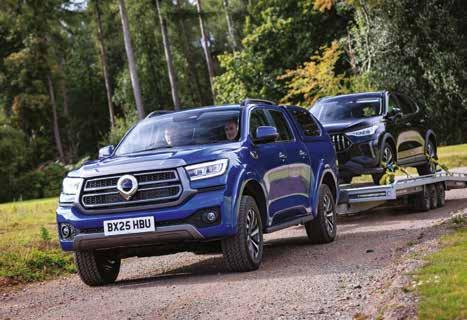
By Ben Freakley, Rivervale.
Despite the talk of rising costs, electric vehicles still make one of the smartest and most sustainable choices a company can take.
Yes, there’s uncertainty around future tax changes and pay-per-mile proposals, but when you look at the full picture, EVs still make a strong financial and environmental case, especially when leased through a business.
The cost case for EV leasing
Leasing remains the most cost-effective way to get into a new vehicle, and that’s even more true with electric. Rather than tying up capital in a depreciating asset, leasing spreads the cost into predictable monthly payments. You also avoid the risk of falling residual values as battery technology moves on or supply and demand effect resale values.
This means businesses can run the latest models with lower running costs, lower Benefit -in-Kind tax, and none of the uncertainty that comes with ownership. For many, the move to leasing has become as much about financial control as sustainability.
At Rivervale, we’ve seen a big increase in small and medium-sized businesses making the switch, realising that electric vehicles are no longer just for early adopters or big firms. They make day-to-day business sense.
ESG matters, and electric helps tick the right boxes
Environmental, Social and Governance (ESG) commitments have become a boardroom talking point across almost every sector. Clients, customers and investors want to see action, not just pledges.
Choosing electric company cars or vans is one of the simplest, most visible ways to demonstrate progress. It immediately reduces tailpipe emissions and helps lower a business’s overall carbon footprint. That matters not only from an environmental perspective but also when bidding for new contracts, particularly with public sector bodies and larger corporates.
By leasing electric through a trusted broker such as Rivervale, businesses can refresh their fleets more often, keeping up with the latest zero-emission models and technology. It’s a low-risk, high-impact move that supports both the bottom line and the brand reputation.

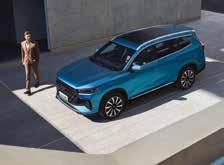
Strong contenders beyond the big names
It’s not just Tesla, Kia and BMW offering compelling EVs anymore. A wave of new manufacturers has entered the UK market, bringing excellent value and generous equipment lists, often at prices that sit comfortably below the £40,000 luxury car tax threshold. There’s great value outside the established brands!
The Geely EX5 is a standout example. This all-electric SUV combines premium looks and impressive build quality with strong range and high-end technology. Inside, you’ll find a large, high-resolution digital display, soft-touch materials and a design that feels more expensive and luxurious than its price tag suggests. It’s a great choice for user-chooser fleets or businesses that want something fresh without the badge premium.
The Chery TIGGO 8 Pro brings seven-seat practicality, bold styling and confident electric performance. The specification is generous, with heated and ventilated seats, a panoramic roof and adaptive cruise control all standard.
The Xpeng G6 is a sleek electric crossover that blends eye-catching design with longdistance capability. It’s smart, well connected and packed with safety technology. For company car drivers, it offers a comfortable and efficient way to travel, with a touch of luxury.
For those running commercial fleets, the MAXUS eDeliver 7 deserves attention. It bridges the gap between compact electric vans and full-size LCVs, offering a useable payload, decent real-world range and modern comforts. For urban deliveries or service businesses looking to go greener, it’s a practical and cost-conscious option.
Residual values on EVs are still finding their level, which is where leasing really comes into
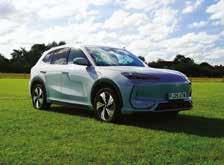
its own. Businesses don’t have to worry about what a vehicle will be worth in three- or four-years’ time; that risk sits with the funder. Servicing costs are typically lower, road tax for zero-emission vehicles is lower, and electricity remains cheaper per mile than petrol or diesel. Even with some of the latest fiscal tweaks, the total cost of running an electric vehicle through a lease is often still lower than a comparable combustion model.
As one of the UK’s leading vehicle leasing brokers, Rivervale works with every major manufacturer and funder to deliver the best deals for business and personal customers. From single company cars to full fleet management, we make the switch to electric simple. Our salary sacrifice schemes are helping employers attract and retain staff, while our fleet management tools give businesses full visibility of costs, mileage and CO₂ savings. Every lease comes with expert advice from a dedicated account manager who can match the right vehicle to your specific business needs.
The bigger picture
Moving to electric isn’t just about numbers on a spreadsheet. It’s about futureproofing your business, showing leadership and embracing cleaner transport. Yes, the headlines might focus on tax changes and rising costs but if you dig a little deeper the story is clear: electric vehicles still make financial and environmental sense for UK businesses.
As things evolve and more brands join the market, choice and competition will increase. Whether you’re drawn to something stylish like the Xpeng G6 or need the practicality of the MAXUS eDeliver 7, there’s never been a better time to explore what’s available.
Leasing through Rivervale means you can stay ahead without the financial risk. You can keep your fleet up to date, support your sustainability goals and keep your drivers happy while protecting cash flow.
With smart leasing options and exciting new models on the market, it’s an opportunity to lead by example, drive down emissions and show that doing the right thing for the planet can also be the right move for your balance sheet.
Want to know more?
Join the many UK businesses already leasing smarter with Rivervale.
Explore our range and everyday low prices at rivervale.co.uk.



CHERY UK has been delighted with the response to its first model for the UK market – the TIGGO 8.
The Chery TIGGO 8 Super Hybrid is a spacious, hybrid-powered SUV that combines striking design with smart technology and everyday practicality. With Chery International-derived brands already making waves in the UK, through OMODA and JAECOO, the arrival of the Chery TIGGO 8 Super Hybrid signals the group’s next chapter.
The Chery TIGGO 8 Super Hybrid is capable of 745 miles, including 56 EV-only miles, is self-charging and equipped with fast charging, too. The hybrid powertrain and ventilated front seats make this a comfortable vehicle and the perfect companion for high mileage UK drivers.
In keeping with its sibling vehicles, the TIGGO 8 offers a high-spec interior, premium finishes and advanced infotainment features.
Chery UK country director, Farrell Hsu, said: “We were delighted to reveal Chery’s
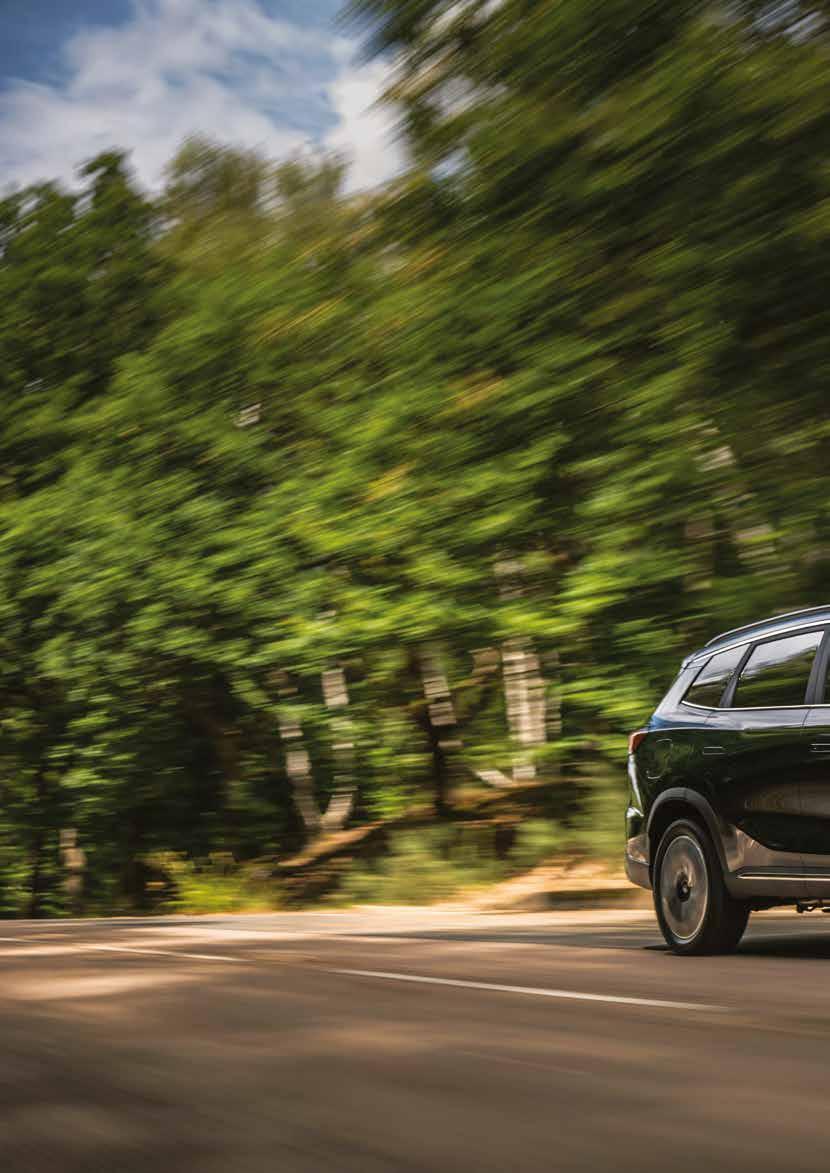
most versatile and refined hybrid SUV yet to a UK audience. The Chery TIGGO 8 Super Hybrid is a perfect expression of what Chery stands for: smart technology, generous space and electrified efficiency without compromise. It’s designed to make people happy, knowing they’ve made the smart choice for their next SUV.”
At the heart of the Chery TIGGO 8 Super Hybrid is Chery’s latest-generation Super Hybrid powertrain – a sophisticated dual-motor full hybrid set-up mated to a 1.5-litre turbocharged petrol engine. It delivers a combined system output of 204 PS and 365 Nm of torque, while offering electric-only driving at urban speeds and impressively low fuel consumption over longer distances.
Inside, the TIGGO 8 Super Hybrid combines comfort and flexibility across three rows of seating (5+2). The digital cockpit features a full-width dual-screen layout with voice control, a Sony 12-speaker system, wireless smartphone integration, ambient lighting and a panoramic sunroof. A
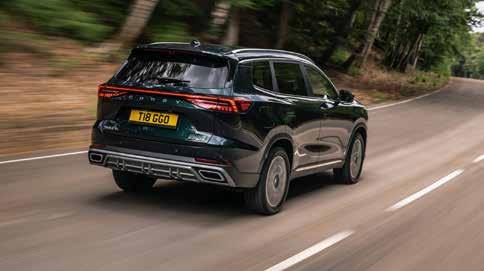
suite of driver assistance systems comes as standard, including adaptive cruise control, cabin filtration system and lane centring.
For UK buyers, the Chery TIGGO 8 Super Hybrid offers the reassurance of a brand with proven international credibility, alongside a comprehensive sevenyear/100,000-mile warranty, whichever comes first.
Chery – the largest exporter of vehicles from China for the past 22 years – has a proven track record of success across global territories. The UK go-to-market strategy features UK-optimised Chery models and combines traditional franchise dealerships with a strong emphasis on warranty and aftermarket care. Many of these dealerships already represent OMODA and JAECOO in the UK.



BYD’s expanding UK model range welcomes two further new models with the announcement of prices, equipment specifications and start of sales for the SEAL 6 DM-i Saloon and Touring. These latest additions to the brand’s fast-growing line-up are available to order now with customer deliveries scheduled to start in December.
On-the-road prices start at £33,990 for the Saloon and £34,990 for the Touring version. The two models share the same high levels of standard equipment that include comprehensive connectivity, safety and driver assistance features across two grades: Boost and Comfort.
The introduction expands BYD’s model range to provide the convenience and versatility of an estate body-style for the first time and give customers the option of BYD’s Super Hybrid with DM (Dual Mode) technology. This BYD-designed intelligent plug-in hybrid system combines the refinement and responsiveness of EV driving with the flexibility of a petrol-electric powertrain.
In the saloon, this can provide up to 87 miles of all-electric urban driving and a potential range of up to 935 miles. Respective figures for the Touring model are up to 81 miles and a range of up to 839 miles.
BYD’S first wagon in Europe
The SEAL 6 DM-i Touring is the first BYD
wagon to be introduced in Europe. It comes with convenience and practicality designedin, the load space offering 500 litres of space with the rear seats in place, loading to the parcel shelf. Quick-release handles make it simple to lower the 40:60 split-folding rear bench, increasing the cargo volume to a maximum 1,535 litres. Access is made easy with a power tailgate, provided as standard on all versions.
Grades and equipment highlights
The entry point to the SEAL 6 DM-i range, and forecast best-selling version, is Boost, which comes equipped with 17-inch alloy wheels, a 3.3kW on-board charger, automatic windscreen wipers and headlights, vegan leather upholstery and steering wheel trim, plus, a six-speaker audio system. Multimedia functions are controlled using a 12.8-inch touchscreen and connectivity is supported by front and rear USB ports – four in total – and smartphone integration via Apple CarPlay and Android Auto. The cabin also features power-adjustable front seats – six-way for the driver and four-way for the
passenger – and footwell and door illumination. A smartphone key can be used for easy vehicle access.
The extensive active safety and driver assistance package includes rear parking sensors, a reversing camera, Blind Spot Detection and Driver Fatigue Management. Rear Cross Traffic Alert and Braking and warnings for forward and rear collision and door opening are also provided.
The Comfort grade builds on this specification with 15.6-inch multimedia touchscreen, 18-inch alloys, a 6.6kW on-board charger, door mirror puddle lights and rear privacy glass. Life on board is enhanced with a panoramic roof with electric sunshade and multi-coloured ambient lighting. Comfort features include a heated steering wheel and heated and ventilated front seats (with a memory position setting for the driver). An eight-speaker HiFi Sound audio package is provided, together with a wireless smartphone charger.
Manoeuvring is made easier with the addition of front parking sensors and a 360-degree camera.
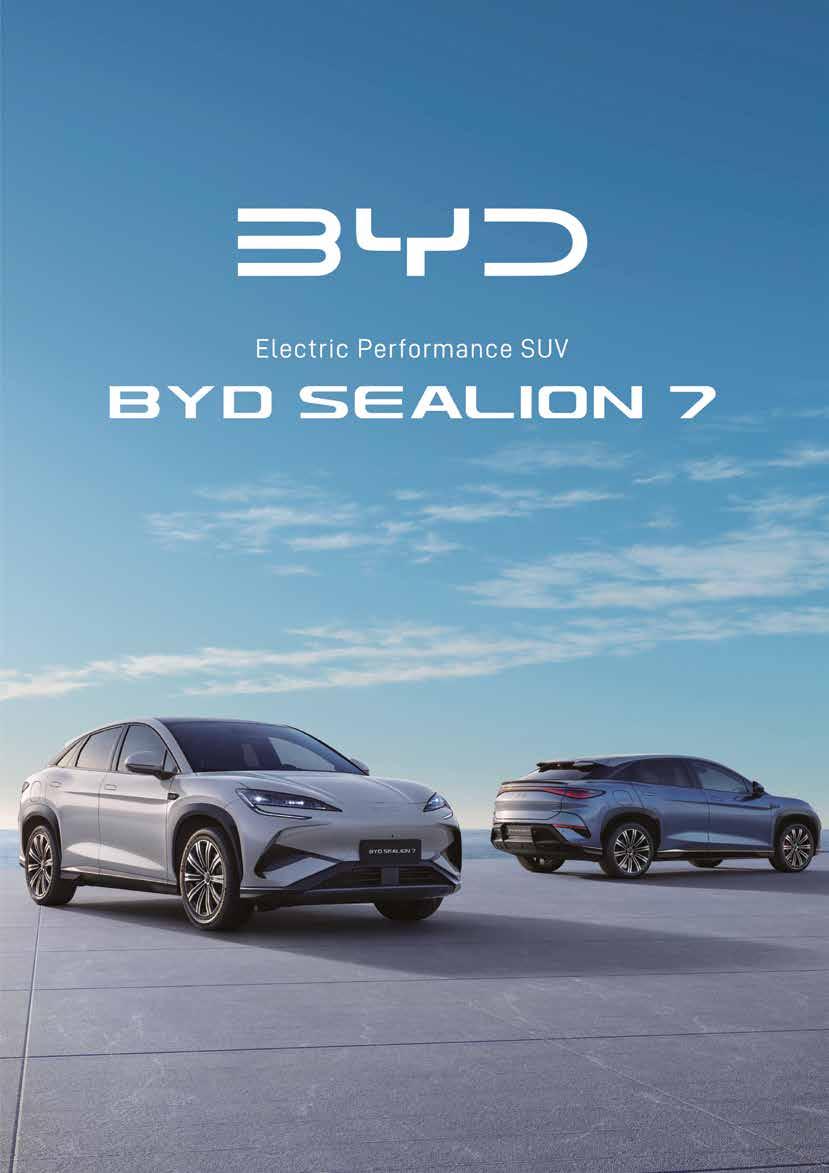
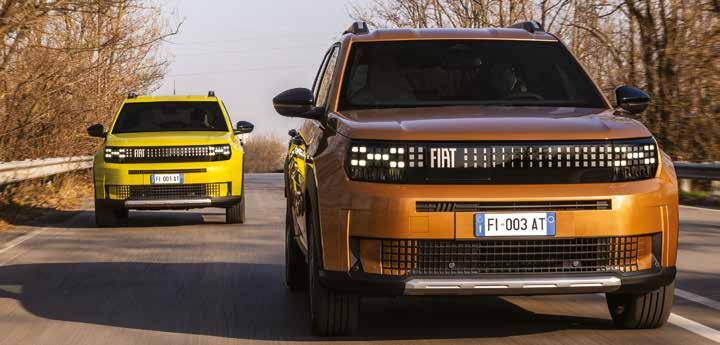
FIAT adds Icon trim level to Grande Panda full electric, previously only available on hybrid versions.
Icon offered as an additional choice for customers alongside the entry level RED and top-of-the-range La Prima version.
Exterior highlights of the Icon trim include 16” black alloy wheels, front and rear skid plates, roof rails and rear privacy glass.
Inside, Icon features ‘Style’ fabric seats with a 40/60 rear split, a soft-touch steering wheel, a 10.25” touchscreen radio with wireless mirroring, and manual air conditioning.
On-the-road price for the Fiat Grande Panda Electric Icon starts at £21,995. This compares with the entry level RED at £21,035 and top of the range La Prima at £24,035.
The reintroduced FIAT E-Grant offers a £1500 saving on the OTR price of fully electric versions of Grande Panda

FIAT has announced changes to its awardwinning Grande Panda fully electric line-up, unveiling Icon as an additional trim level. Icon was only available previously on hybrid versions.
Fiat Grande Panda Electric Icon will be offered alongside the entry level Grande Panda RED and the top-of-the-range Grande Panda La Prima. The fully electric powertrain combines a 44kWh battery with an 83kW e-motor (113 HP) and has a WLTP range of 199 miles.
The launch of Icon is consistent not just with its availability on hybrid versions of
Grande Panda but with its recent introduction as a trim choice on Fiat 600.
Designed to provide customers with even more choice, Grande Panda Icon specification includes 16” black alloy wheels, front and rear skid plates, roof rails and rear privacy glass. The interior features ‘Style’ fabric seats with a 40/60 rear seat split, for added practicality, and manual air conditioning. In addition, a 10.25” touchscreen radio incorporates wireless mirroring for optimised communication and convenience.
The on-the-road price for the Fiat Grande Panda electric Icon is just £21,995. The
Grande Panda electric range starts with the entry level RED, priced at just £21,035, while the top-of-the-range La Prima is £24,035. All three electric versions of Grande Panda qualify for the recently reintroduced FIAT E-Grant, which offers a £1,500 saving on the on-the-road price of all fully electric FIAT and Abarth models.
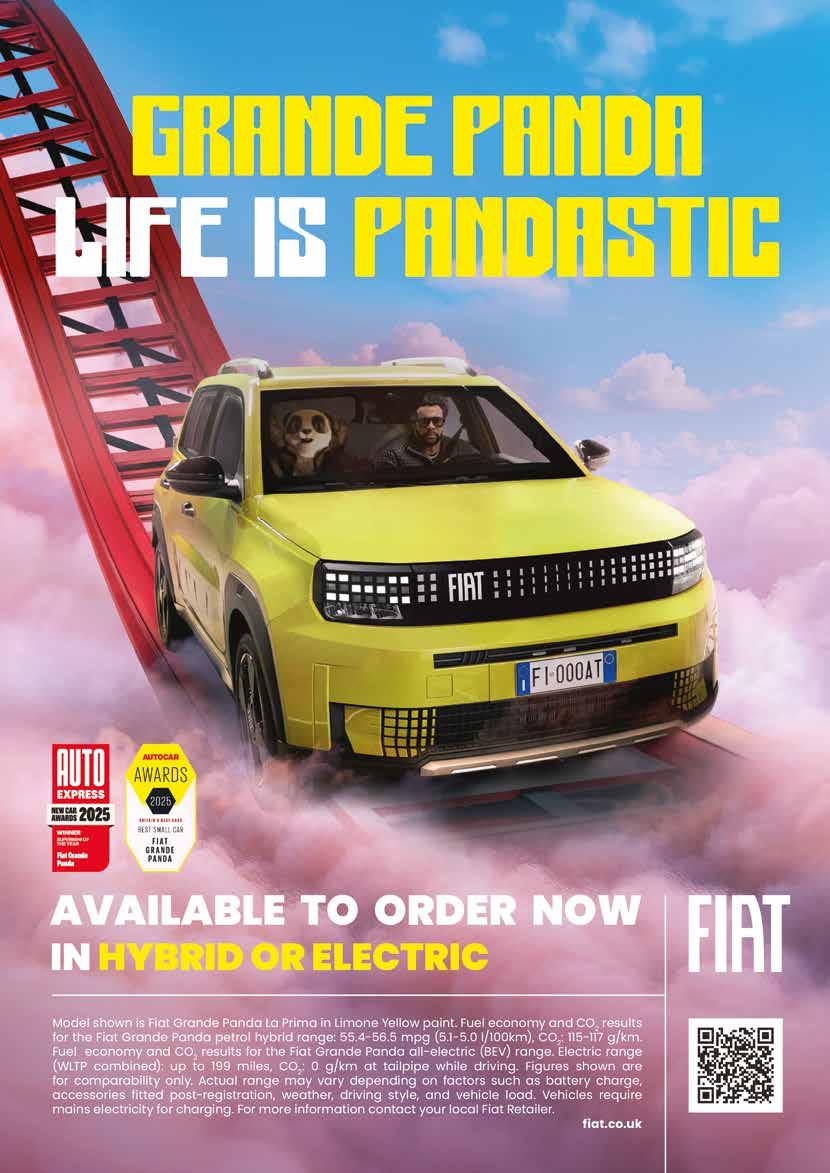

The latest MG is the all-new IM6, a pure electric intelligent SUV with supercar power and advanced driving technologies, all wrapped in an elegantly flowing form.
In many ways the MG IM6 is a contradiction in the best possible way, where advanced technology meets old school driving pleasure, backed by infotainment systems that are on another level to those found in rivals.
Inside the MG IM6, advanced technologies power a future of travel that’s here now, and refreshingly uncomplicated. Driving the MG IM6 feels like the future you’ve been waiting for.
The MG IM6 brings performance in the form of 751hp ‘Hurricane Motor’ capable of 0-62mph in 3.5 seconds on the dual motor version. The 100kWh battery pack is capable of up to 388-mile WLTP combined range 800v while also providing best in class
The MG IM6 uses deep level vehicle intelligence to refine handling, comfort and safety through its digital core. The MG IM6 is in constant dialogue with the road –scanning, computing, and adjusting –providing an intuitive and worry-free
MG IM6 100 LONG RANGE
20” Aero Wheels
Rear Wheel Drive
Maximum Torque (Nm/lb ft)
500/368
Maximum Speed (mph) 146mph
WLTP City EV Range 510 miles
Key facts and figures Up to 388 miles (WLTP Combined Range)
10-80% Charging time using DC Rapid Charger – 17min
0-62mph acceleration time 3.5 seconds
experience, so you can just drive.
One example of this is automated precision driving. This helps you to effortlessly park and pull out, as well as park and reverse with One-Touch iAD.
It is a standard equipped piece of driving assistance technology in MG IM6 that effectively eliminates the pain points from manoeuvring an SUV in tight spaces.
Another great addition to the IM6 itinerary is advanced skid prevention. Hydroplaning stability control helps to dramatically reduce the chance of losing control in extreme weather conditions by 80% compared to traditional vehicles.
It also features smooth braking
Battery Capacity 100kWh
Maximum Power (kW/PS) 300/407
0-62 mph 5.4 Seconds
WLTP Combined EV Range 388 miles
Max DC Charging Speed 396kW
technology. Designed to deliver silky smooth braking, ICS, or Intelligent Comfort Stop refines braking jerkiness and make startstop traffic driving a little more seamless.
In addition, four-wheel steering helps you to navigate tight U-Turns easier with Four Wheel Steering System, equipped as standard, so the MG IM6 can brilliantly pivot with the agility of a compact car.
Inside the driver will find elevated levels of comfort and technology. The showpiece ultra-wide 26.3” touchscreen can toggle between light and dark modes, with all the key driver information on display to deliver the feel of a technological command centre or serene oasis for the driver.
Wireless Apple CarPlay®, Android AutoTM, and convenient ventilated wireless phone charging are all within easy reach and conveniently connect to the ultra-wide infotainment screen.
Ultra soft leather-style seats provide heating and ventilation functions on front seats and heated outer rear seats to make the MG IM6 feel like the business lounge of car cabin.
Rear occupants will appreciate the adjustable rear seat backrests to fully enjoy the panoramic glass roof, all within the serene hush created by the double layer soundproof glass. Bliss.
20 speakers deliver sound so crisp you can hear the guitarist blink, while double layered glass and road noise cancelling technology brings a quiet so profound it’s almost meditative.
A cavernous 665L boot space is supplemented by a neat 32L ‘frunk’, and hidden storage compartment under the boot floor – perfect for keeping essentials secure.

Company Car and Van has long been fans of the KIA range, and the new EV4 is an example of why we love them so much. Read on ...
Model choice and battery
The EV4 is offered in three trim levels.
Entry level Air , GT-Line and GT-Line S. Air is the only model offered with the standard range 58.3 kWh battery, while all three are available with the long range 81.4 kWh battery. The new Fastback model is only offered in GT-Line and GT-Line S paired with the 81.4kWh battery.
Drivetrain and performance
All versions are front-wheel drive with a single motor producing 150 kW or 201 bhp with 283 Nm of torque. Acceleration from 0-62 mph takes 7.5 seconds in the standard battery, then 7.7 seconds with the long range battery, both coming with a top speed of 105 mph.
The EV4 uses the 400V version of Kia’s E-GMP-derived platform, so is a little slower to charge than those fitted with the 800V set-up. Choose the Fastback and this will accelerate to 62mph in 7.9 seconds, going on to a top speed of 105mph
Battery and range
Entry level Air with the standard battery will travel 273 miles, while the larger battery versions go further. In Air trim, it’s 388 miles, while in the heavier GT-Line and GT-Line S the range falls to 362 miles. The EV4 Fastback offers a driving range of up to 380 miles.
The standard range battery will take just 29 minutes to charge from 10-80 % using DC fast charging. At home on a 7.4kWh wallbox a full charge will take eight hours. Choose the long range battery and these times are 31 minutes and 11 hours respectively. As ever if you can get a home charger, plug in at night when rates are cheaper, in our case for 5 hours at 9p/kWh and you can add 37kWh overnight for just £3.33.
Specifications
Kia was quick to point out that all versions are well kitted out so if you stick with entry level Air it comes with 17” alloys, the 12.3” digital driver display which is joined to the 12.3” central touchscreen and 5.3”climate screen to make one smooth infotainment bar. Wireless Apple CarPlay, Android Auto, SatNav, heated front seats, a heated steering wheel, dual zone climate, a reversing camera, adaptive cruise control and keyless entry further illustrate this.
Outside
Very aerodynamic and smart-looking. The smooth sides and on our test car GT-Line S

the black B and C pillars make the windows appear frameless. At the rear wide tail lights stretch down each corner and partially across the boot with a sloping rear window and spoiler finishing things off.
Inside
The EV4 uses the same dashboard design as the EV3, so you’re greeted by a familiar one screen set-up, a column-mounted gear selector which also includes the starter button. In the centre binnacle though there’s no sliding mini-table, rather a storage space and the short-cut buttons and air vents are also different. Talking of the shortcut buttons, the touch sensitive panel dashes cream finish means that it’s quite difficult to read these especially if it’s sunny. As it goes darker they are back-lit so Home, Map, Search, Media and Setup are revealed.
We drove the GT-Line GT-line S models and although the dash front and door arm rest finishes are soft touch and tactile, there’s no hiding the fact that if you look more closely the lower down plastics are mostly hard, including the centre armrest bin, door pockets and B pillar trims.
All versions are fitted with the excellent twin 12.3” displays and 5.3” climate display, that’s partially obscured by the steering wheel. These are cleverly mixed with some physical controls allowing the driver to access climate, for example, without using the touchscreen. The system is easy to work. Wireless Apple CarPlay and a wireless charging pad make connecting your iPhone a doddle. The touch-sensitive panel beneath the screen is a great inclusion.
Five driving modes: Eco, Normal and Sport, My Drive, plus a Snow option. Each does what it says on the packet, although Sport isn’t really sporty, rather altering the feel of the steering and accelerator pedal.

Which brings us to the i-Pedal. Alongside the driving modes, the EV4 has several levels of regeneration; Zero,1, 2, 3 and then the i-Pedal. This allows you to add some regenerative braking to the drive via the steering wheel paddles.
The ride felt better than the one we experienced in either the EV6 or EV3. Could that be the Berkshire tarmac we drove on or is it because Kia have improved this as the EV4 is newer? We’d like to thank the latter. Softer suspension seems to be the key and we found it always seemed to adjust to the road accordingly.
The steering’s okay if a little vague at lower speeds and as with other EVs, if you go faster than 50mph this improves. The regenerative braking works extremely well but for fun it’s best at the lowest setting, while full i-Pedal is the obvious choice in town.
A short sprint on the M4 left us impressed. There’s not enough acceleration for out and out thrills but you still get plenty of power for safe overtaking. The suite of on-board safety features take that Smart Motorway hassle away. Only a small amount of road and wind noise makes its way into the cabin.
Pros
Quiet, spacious cabin, great infotainment and a smooth practical ride. Long Range battery should deliver a decent range.
Cons
Some cheap plastics in the cabin. Drives well but isn’t thrilling.
CC&V VERDICT
The electric car plenty of others wished they could build. The long range version with a 380+ mile range hits the sweet spot.
CC&V RATING: N N N N N


AS the UK fleet market accelerates toward an electric-first future, XPENG is emerging as one of the most exciting new entrants— bringing advanced technology, high efficiency, and premium design to business drivers.
Brindley XPENG Wolverhampton is proud to be at the forefront of this movement, offering the latest XPENG models and supporting company car drivers with competitive running costs, impressive range, and cutting-edge safety.
Located in the heart of the West Midlands at West Street, Wolverhampton, Brindley XPENG Wolverhampton is one of the first dedicated XPENG retail and service points in the country. As part of the established Brindley Group, the dealership delivers the trusted service and fleet expertise that business customers expect—paired with the innovation of one of China’s most forwardthinking EV manufacturers.
Introducing the XPENG line-up for the UK XPENG’s arrival in the UK begins with a focused range designed for business practicality, driver comfort, and premium electric performance.
The headline model for fleet and company car drivers, the XPENG G6 is a sleek electric SUV built on XPENG’s SEPA 2.0 platform— offering exceptional range, fast-charging capability, and intelligent software.
“The
XPENG G6 is a sleek, electric SUV... offering exceptional range, fast charging capability and intelligent software...”
Designed to compete directly with premium EV rivals, the G6 combines a spacious interior with class-leading technology, making it ideal for high-mileage business use.
Key highlights include:
n Up to 354 miles (WLTP) of range, reducing charging stops for long-distance business travel.
n Ultra-fast charging, with 10–80% in as little as 20 minutes—ideal for drivers on tight schedules.
n Smart cabin experience, backed by XPENG’s advanced infotainment and driver-assist technologies.
n Impressive efficiency, reducing whole-life costs for fleets.
Joining the G6, XPENG is set to introduce
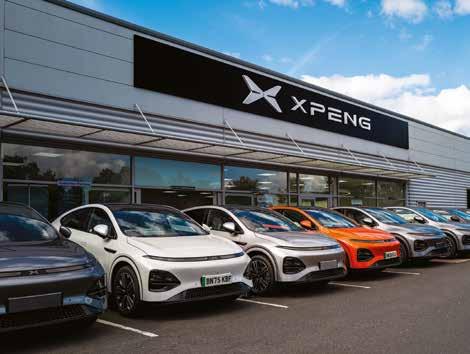
additional models for UK customers, expanding options for both company car drivers and commercial fleets. The upcoming range will include:
XPENG P7, a premium sports sedan with strong appeal for user-chooser company car lists.
XPENG G9, a larger luxury SUV offering executive comfort and long-distance capability.
These models will roll out in phases, and Brindley XPENG Wolverhampton will be supporting early adopters with test drives, fleet evaluations, and tailored business support.
For company car drivers, XPENG’s technology-driven approach delivers meaningful savings and day-to-day convenience.
With 2% BiK applicable to fully electric vehicles, the XPENG G6 and upcoming models offer significant tax advantages for drivers and employers compared to petrol, diesel, or plug-in hybrids. Over a typical three-year cycle, this creates substantial cost savings.
Reduced running costs
EV powertrains offer lower maintenance needs, fewer moving parts, and lower energy costs—making XPENG models a strong choice for fleets seeking predictable budgets.
Premium range and charging efficiency Long-range capability and fast charging
reduce downtime, which is vital for drivers covering large territories or scheduling multiple appointments daily.
Advanced technology for safer, smarter driving
XPENG’s intelligent driver-assist systems support stress-free motorway driving, enhanced safety, and reduced fatigue— benefits that contribute directly to safer fleet operations.
Experience XPENG at Brindley XPENG
As more businesses review their fleet sustainability strategies, XPENG provides a compelling alternative to traditional premium brands — but without the premium price tag.
Brindley XPENG Wolverhampton offers:
n Corporate test drive programmes for fleet managers
n Whole-life cost comparisons to help inform procurement decisions
n Dedicated business specialists
n Flexible funding options, including leasing and salary sacrifice
n Full aftersales support, delivered with Brindley’s long-established reputation for customer care
Company car drivers can experience the XPENG G6 first-hand at the Brindley XPENG showroom, where our team is ready to demonstrate the model’s technology, comfort, and business-friendly efficiency.
n For contact details, see the advertisement on the facing page

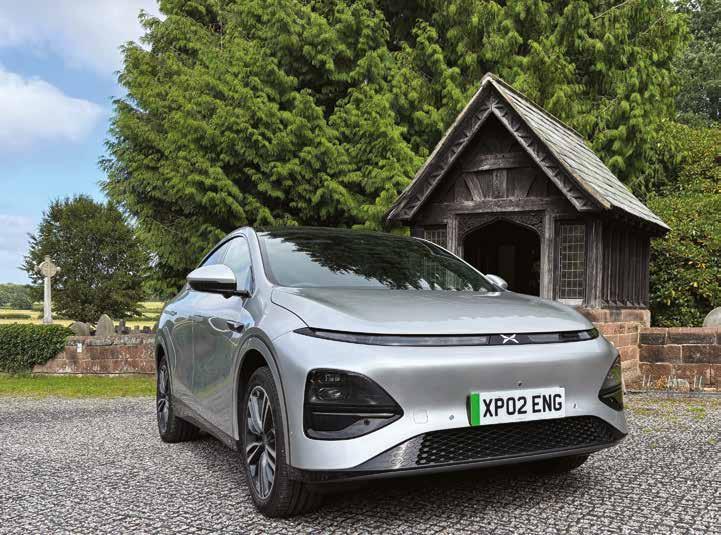
Another day, another Chinese car brand launches. At least that how it seems. So who are XPENG and what cars do they build? Let’s explain.
XPENG is another Chinese brand; andit’s launched the G6, a Tesla Model Y competitor, with a G9 and luxury MPV to follow. The brand is sold in the UK by International Motors, a company with a history of championing Far Eastern brands including Subaru and Isuzu pick-ups.
This five-door electric RWD SUV hatchback has smooth lines, a slim bonnet, a front light strip with central X, a Porscheesque narrow rear light strip, steep rear window and slim side windows with pop out door handles.
Two versions are offered: a G6 RWD Standard Range which comes with 254bhp and which will go from 0-62mph in 6.6
seconds; and the 281bhp XPENG G6 RWD Long Range. This hits 62mph in 6.2 seconds. Both have a top speed of 124mph.
XPENG’s designers have plainly studied the Tesla Y very closely as the inside of the G6 is equally as minimalist and features the same steering wheel controls and 15” central touchscreen. You also get a 10.2” driver’s information display which illustrates range, speed, tyre pressure, vehicles around you and driving mode.
Quality throughout is very good with a mix of soft plastics and tactile fabrics and synthetic leather for the seats. The steering wheel is an odd squared-off circular shape with just two spin wheels on the centre section that control the media, volume, cruise control when in use, the climate when not. The right side stalk is for the gears and
pushing it all the way down engages cruise control. The left-hand stalk controls the wipers and lights.
The cabin is spacious with excellent front head and legroom, as does the rear where three adults can sit side by side. The large windscreen offers a great forward view, but both the narrow rear window and shallow side windows make parking a tad difficult and you’ll need to utilise the side mirrors using the screen sub-menus and reversing camera on occasions. The steering wheel adjusts fore and aft and the electric seats offer a memory function and are heated too.
Infotainment
Any Tesla customer will be familiar with the clutter-free set-up with almost all functions going through the screen. SatNav, DAB, Apple
Continued on page 38


Continued from page 36 CarPlay and Android Auto are all included. The Snapdragon processor makes the screen quick and responsive, although you’ll need a bit of time to get used to the menus.
and batteries
The G6 is based on the latest generation of XPENG’s SEPA 2.0 platform built on 800-volt technology. This makes the G6 capable of super-fast charging with a charging capacity of up to 280 kW. Charging the battery from 10 to 80% takes less than 20 minutes. You can choose a 66 kWh battery with a 270-mile WLTP driving range or an 87.5 kWh battery with a 341 to 354 miles WLTP driving range. At home a 7.4kWh charger will replenish the Long Range in 11 hours.
Driving
You can select from four driving modes. Eco, Standard, Sport or Individual and within each can adjust the power steering and
braking between Comfort, Standard and Sport. Regeneration levels can also be altered with Low, Medium High and XPedal the options, the latter offering almost one pedal driving.
For the thrill of it when you’re in Sport mode there’s a Launch option which was great fun unleashing the car’s full potential.
Despite the power on tap it’s an easy car to drive, quiet, refined and comfortable and one of the better Chinese EVs for all of these.
The acceleration isn’t crazy either so when exiting junctions this doesn’t result in any wheel spin as the safety features on board control the car with ease and it behaves itself well, even when you use the Launch function.
Day to day in my local town it was a relaxing car to be in and on a 100-mile motorway trip, one of the best cars I’ve driven all year for striking the comfortrelaxed-fun balance. The lack of obtrusive safety alerts is also good news, with XPENG’s designers realising that most of us can

decide when to put the brakes on. If you engage the regeneration through the brake pedal this too is very good, with no noticeable transition between the regenerative set-up and the conventional discs and brake pads.
As far as driving range goes we were driving in a balmy July and were getting 3.8kWh per mile which is good for us, so the claimed 354 miles may be doable in summer in Eco driving mode. We’d surmise that 300 miles is more likely. A final footnote on the battery itself; XPENG has done a very good job of masking the battery weight beneath the car and it doesn’t overwhelm any of the cars drivability
Striking exterior, quality interior with plenty of space for five. Drives and handles exceptionally well. Competitively priced. Just 3% BIK.
It’s fun but not quite as exciting to drive as some competitors. The lack of physical buttons in the cabin to adjust simple things is a touch annoying.
BYD, MG, Omoda and Jaecoo may be leading the Chinese charge but we reckon the XPENG could be the best of the bunch if the G6 is anything to go by. We’d be happy driving a G6 everyday. Perhaps the lack of out and out power might put some off, but with prices of £45,000 for the Long Range model and a five-year warranty it’s a company car driver’s dream !
CC&V RATING: N N N N N

Isuzu launches new D-Max V-Cross Commercial
It’s a premium-spec, two-seater pickup engineered for SMEs, farmers, trades, and construction professionals
Permanent cabin conversion into a secure load zone and full commercial specification.
Fully compliant as a commercial vehicle with VAT reclaimability and a flat £4,020 BIK rate, ensuring long-term tax efficiency.
Priced at £41,995 CVOTR
ISUZU has launched its new D-Max V-Cross Commercial, a premium pick-up specifically engineered for the commercial sector.
Designed for SMEs, farmers, tradespeople, and construction professionals, this new model offers the comfort and specification of the flagship V-Cross combined with full commercial compliance and long-term tax efficiency.
Designed for Business Use
Purpose-built for business, the V-Cross
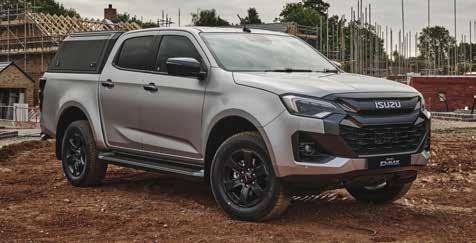
Commercial is based on the award-winning V-Cross Double Cab and has been professionally converted into a two-seater model to meet the needs of commercial operators.
The rear passenger space has been permanently adapted into a secure load zone, ensuring the vehicle cannot be returned to a passenger configuration.
The V-Cross Commercial comes equipped with a comprehensive commercial-ready
specification as standard. This includes a lightweight commercial canopy, tow bar with towing electrics, load bed liner, rear passenger door window tints, and protective driver and passenger seat covers. To further underline its identity as a serious business tool, the vehicle is registered exclusively as a commercial model and carries distinctive “Commercial” badging.
Continued on page 40

Continued from page 39 Capability and performance
This new model retains the proven strengths of the award-winning D-Max range. With a 1-tonne payload, 3.5-tonne towing capacity and full four-wheel drive, the V-Cross Commercial is ready for tough jobs across farms, worksites, and rural landscapes. For even greater control in challenging conditions, it also comes with Rough Terrain Mode and a rear differential lock, delivering ultimate confidence when tackling demanding off-road environments.
The perfect business model
Designed to help businesses maximise value, the D-Max V-Cross Commercial retains its full commercial vehicle tax status. VAT is reclaimable for VAT-registered businesses making fully taxable supplies, while road tax is kept at a fixed rate of £345. It also continues to qualify for Plant & Machinery Allowance under Capital Allowances, retaining 100% writing down status.
For company drivers, the model keeps its flat-rate £4,020 Benefit in Kind for the 2025/26 tax year. These benefits are particularly significant for SMEs and self-employed professionals looking to reduce the potential costs introduced under the new April 2025 legislation changes affecting double and extended cab pick-ups.
Premium features for everyday driving
Built on Isuzu’s highest trim level, the

V-Cross Commercial ensures that long days behind the wheel remain comfortable. Drivers benefit from leather upholstery trim, dual-zone climate control, a fully wireless
“Designed to
help businesses maximise value, the D-Max V-Cross Commercial retains its full commercial vehicle tax status... VAT is reclaimable for VAT-registered businesses...’
9-inch infotainment system with wireless Apple CarPlay and Android Auto, and a new 7-inch Multi-Information Display. USB-C ports and an upgraded ADAS suite, including Intelligent Adaptive Cruise Control and Traffic Jam Assist, provide modern convenience and safety for business owners who spend significant time on the road.
Alongside its tax and financial advantages, the V-Cross Commercial offers the reassurance of Isuzu’s market-leading ownership package. Every model comes with a five-year/125,000-mile warranty, plus five years of UK and European roadside assistance.
With a kerb weight under 2,040kg, it also qualifies for passenger car speed limits on dual carriageways and motorways, helping business users get where they need to be quickly and efficiently.
Managing Director at Isuzu UK, Alan Able, commented on the new model launch: “The V-Cross Commercial is the perfect solution for SMEs, trades, farmers and construction professionals. Our loyal customer base old us they wanted all the key attributes of a rugged 4x4 pick-up combined with the premium features of our flagship model. The V-Cross Commercial delivers exactly that.”

BUSINESS owners and fleet managers across Shropshire and Mid Wales now have a new home for rugged, reliable pick-ups: JT Hughes Shrewsbury Isuzu, the newly appointed official Isuzu dealer for the region
Located on Battlefield Road in Shrewsbury, we are fully operational while our new dedicated showroom is under development, offering the full Isuzu D-Max range along with aftersales support, servicing, parts and fleet-focused expertise.
The appointment is a major development for commercial vehicle buyers in the area. It’s particularly relevant for those in construction, agriculture, utilities and local trades, where dependable pickups are more than just transport — they’re essential business tools.
Led by experienced branch manager Scott Thomas, the team at JT Hughes Isuzu takes a consultative approach to supporting businesses. Whether you run a single vehicle or manage a growing fleet, you’ll get expert advice with flexible options including contract hire, leasing, and fleet maintenance packages
“We’re here to support working professionals who rely on their vehicles to get the job done,” says Scott. “With the

D-Max, you’ve got a pick-up that’s built for hard work, and we’re here to make sure the ownership experience is just as dependable.”
Already well known for its towing capacity, practicality and five-year/125,000-mile warranty, the Isuzu D-Max is a top choice for commercial use. Now, with a dedicated dealer in Shropshire, local buyers benefit from hands-on support without the long travel times.
Fleet buyers can test drive models from across the D-Max range, including the Utility, DL20, DL40 and V-Cross. On-site servicing, business finance options and priority parts ordering are all available to keep businesses
“The team at JT Hughes takes a consultative approach to supporting businesses... you’ll get expert advice with flexible options...”
running smoothly.
JT Hughes brings decades of experience to the Isuzu brand. The Shrewsbury site is set up with commercial customers in mind, offering easy access from the A49, modern service bays and a large forecourt.
Whether you’re a rural business in Mid Wales or managing trade vehicles across Shropshire, JT Hughes Shrewsbury Isuzu is ready to support your fleet needs.
Visit: Battlefield Road, Shrewsbury Call: 01743 460444
Or see: jthughes.co.uk



A TRIP to Athens saw CC&V get to grips with the latest Volkswagen Transporter van. Based on the class-leading Ford Transit Custom, the Ford/VW strategic partnership has already delivered the Connect/Caddy and Ranger/Amarok. Transit Custom sales dwarf those of the Transporter, but Volkswagen has come out fighting, pitching the Transporter at a lower list price, a longer warranty and a higher specs. Diesel and electric versions are available, and here’s what you need to know about the diesel.
What is it?
This is the seventh generation Transporter, and has an enlarged load, passenger space, a higher payload and increased efficiency. From launch there’s a Panel Van, with Kombi, Shuttle and Double-Cabs following later in 2025. All models are available with turbodiesel, plug-in hybrid and electric drives.
The TDI diesel comes with three outputs: 81 kW (110 PS), 110 kW (150 PS) and 125 kW (170 PS). The 125 kW TDI is always combined with an 8-speed automatic gearbox, an option on the 110 kW TDI as an alternative to the 6-speed manual gearbox. The 110kW and 125kW can be ordered with 4MOTION AWD.
A plug-in hybrid will arrive in 2026 with 171 kW (232 PS). The electric option has a 65kWh battery.
Three trims: Commerce, Commerce Plus and Commerce Pro. All are available as either standard or long wheelbase.
Commerce comes with 16” steel wheels, LED headlights, rear wing doors, near side door, 12” driver’s display, 13” touchscreen, cruise control, rear parking sensors, keyless start and Wireless App Connect.
Commerce Plus adds body-coloured bumpers, a leatherette steering wheel, front and rear parking sensors, a rear-view camera, keyless start with Safelock and an anti-theft alarm.
Range-topper Commerce Pro ups the ante with 16” alloys, a heated windscreen, heated seats, wireless phone charging, auto air-con, Adaptive Cruise Control, Blind Spot Assist, extra USB ports and super-bright LED lights in the load area.
The panel van with standard wheelbase and normal roof has a load capacity of 5.8 m3,

0.3 m3 more than its predecessor. The high roof and long wheelbase increases this to 9m3 with the maximum payload up from 1.2 tonnes to 1.33 tonnes. Three Euro pallets now fit inside. Payloads range from 767kg on the 150PS 2.0 TDI 8 speed up to 1238kg in the 170PS 2.0 TDI 8 speed auto SWB model. There’s a 1,400mm aperture for the back door with 1,932mm of space between the arches.
The SWB offers 5.8 cu m3 of space increasing to 6.8cu m3 for the LWB model.
Standard equipmentis excellent and includes Autonomous Emergency Braking, Lane Assist, front and side curtain airbags, cruise control, rear parking sensors, Dynamic Road Sign Display and Front Collision Warning.
Climb aboard and the interior immediately smacks of quality. The electric handbrake is located between the centre air-vents and the gear selector is on the right steering wheel stalk, freeing up floor space for easier access. If there are three in the cab, there’s decent legroom for the centre passenger.
Infotainment
Touchscreen inputs and menus are
straightforward. There are some physical buttons on a single section under the screen. Apple CarPlay and Android Auto are included as standard.
Up front there are two USB inputs and a 12v socket in the centre dash as well as a clever pull down cup holder. The doors feature three storage spaces, with a dash top open area in front of the driver as well. There’s a good sized glove box and even a dash top mounted closing box in front of the passenger.
Our test cabin also had two more USBs within the dash top open area.
The Transporter diesel is available with five Drive Modes; Normal, Eco, Sport, Slippery and Tow/Haul. These tailor throttle response, steering and gear-change, based on the outside environment and weather conditions. From the driver’s seat everything is easy to reach including the touchscreen. Visibility is also good, although you will need to lean forward to look left on some occasions. On some narrow, winding and hilly Greek roads the auto is an absolute doddle to drive and there is enough power to make it up steep inclines with power to spare. On a short dual carriageway we engaged cruise control and

comfortably overtook some slow-moving traffic. Cabin insulation is very good.
Performance and fuel economy
The diesels will hit 62mph in 13.4 – 16.9 seconds dependant on model. Combined economy ranges from 31.4-40.9 mpg
Pros
Practical and drives beautifully. Classy user-friendly interior. Plenty of model choice.
Cons
Almost but not quite the same as a Ford Transit Custom.
Similarities to Ford Transit Custom may upset Volkswagen loyalists, but utilising a tried and tested platform and Ford engines has pushed VW to a better, more practical panel van than it had before. Trims and finishes feel nicer than Ford’s, and the cabin feels classier, more modern and more durable too. We liked it.
CC&V RATING: N N N N N


“It’s
been pushed hard to become a better, more practical panel... trims and finishes feel nicer than Ford’s, and the cabin feels classier...”
A NEW name in the UK light haulage sector is Farizon. While in itself not the best-known name here, it is the commercial vehicle arm of a much better known company, Geely, which has strong ties with this country’s traditional black cab sector through its ownership of the London Electric Vehicle Company – formerly known as the London Taxi Corporation, which builds black cabs in Coventry.
The Farion CV range is currently focused on the SV model range. This line-up includes the option of a 67 kWh or an 83 kWh lithium iron phosphate (LFP) battery, with a 106 kWh nickel manganese cobalt (NMC) battery available for the L3 H3 model. All battery options feature advanced cell-to-pack technology, reducing weight while increasing battery capacity and body rigidity.
One efficient, all-electric powertrain will be available, featuring a permanent-magnet synchronous motor with an eight-layer, flat wire configuration which produces 170 kW (231 PS) of power and 336 Nm of torque.
The first deliveries of the Farizon SV arrived in the UK in late spring. All variants will benefit from a standard four-year / 120,000-mile warranty (eight-year / 120,000-mile for the battery) demonstrating Jameel Motors’ confidence in the SV’s long-term reliability and durability.
A high level of standard equipment includes features such as automatic headlights with Intelligent High Beam Control, automatic wipers, an advanced 360°

ventilated seats for driver and passenger, and a heated windscreen.
Also fitted as standard is an innovative payload monitoring system, which uses ride-height sensors used to calibrate the vehicle’s weight. An accurate payload read-out on the LCD driver’s display helps drivers and fleet operators ensure that they are meeting gross vehicle weight regulations. Overweight loads are alerted to the driver.
Other standard features adding comfort and convenience include, advanced connectivity, a heated multi-function steering wheel, high-power USB charging, automatic air conditioning, physical buttons
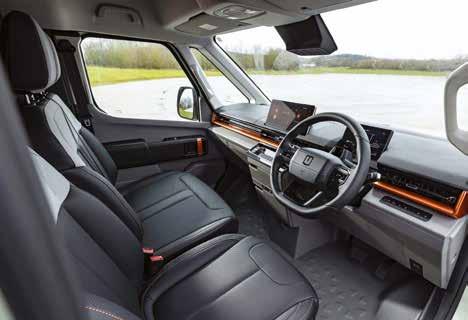
alongside touchscreen control, three-seat layout, a full-size spare wheel, and a full suite of advanced safety and assistance systems. The standard paint finish is white.
Optionally available are:
Exterior paint finish (Cyan, Black, Blue, Gold and Grey): £550 + VAT
Vehicle-to-load (V2L) system (220 v / 3.3 kW): £500 + VAT
Towing package, fitted (crossbar, towball, towing electrics module): £400 + VAT
270-degree rear doors: £300 + VAT
Tom Carney, managing director, Jameel Motors UK added: “We already knew that the Farizon SV would be a unique product in this competitive segment, and now we know it will be ultra-competitive on price and significantly exceed expectations for standard specification, too.
“Not only is the list of standard features impressive, the SV also includes features that aren’t available at all on competitor models, like the weight monitoring system.
“That explains why we are seeing such excitement and interest in the SV from fleets large and small.”
